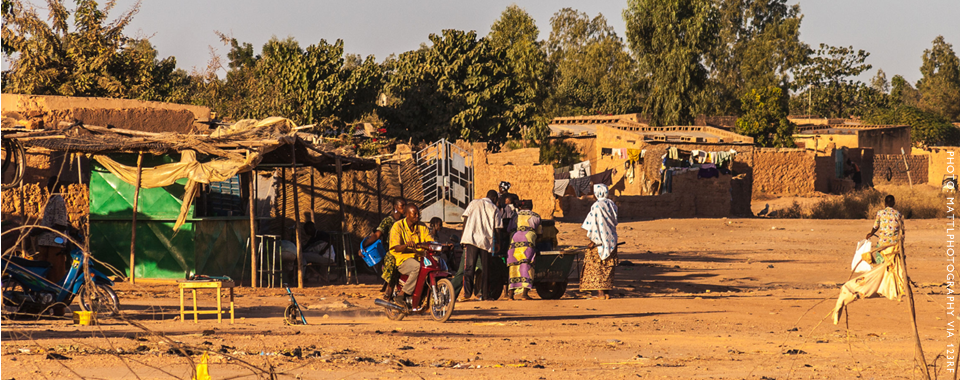BY MARCEL MAGLO AND FIONA GRATHWOHL
Burkina Faso, formerly considered one of West Africa’s most stable countries, now rates as the fourth most worsened country in the 2020 Fragile States Index (FSI). The country has seen mounting threats to its peace and security over the past five years, despite government efforts to manage the pressures. Much of this is from wider regional instability that has spilled across Burkina Faso’s borders. In 2019, Burkina Faso witnessed more violence than any other year in its recent history, bringing to a halt the slow but incremental improvements the country has enjoyed across many of the FSI indicators since 2013.
Despite its relative stability, Burkina Faso has not been immune from violence over recent years, particularly as the situation in Mali has continued to deteriorate. For example, 2015-2016 saw a serious uptick in fatalities following a series of terrorist attacks linked to al-Qaeda and groups affiliated with the Islamic State. Since then, there has been a gradual and sustained increase in fatalities resulting from terrorism violence against civilians, with over 3,000 casualties reported between 2016 and 2019, accompanied by an unprecedented humanitarian crisis resulting in over 600,000 displacements and 2,000 school closures.[1] Due to the spillover effects of the security crisis in Mali (which itself rates as the 8th most worsened country on the 2020 FSI), violence has grown exponentially, involving al-Qaeda affiliates such as the Group for Support to Islam and Muslims (GSIM) and the Islamic State in the Greater Sahara (ISGS). These organizations operate between Niger, Mali and far into the Northern, Eastern, and Sahel regions of Burkina Faso and carry out indiscriminate attacks against civilians and the Burkinabé security and defense forces, contributing to the deteriorating security landscape.

Furthermore, the weak presence of the state at the sub-national level has contributed to persisting tensions, which continue to erode existing traditional resilience mechanisms. The governance gaps in rural areas have led to bitter intercommunal conflicts over land and resources, which often degenerate into score-settling and violence. In turn, local authorities have been weakened and incapable of defending the communities against the attacks and reprisals perpetrated by the various armed groups, including the security forces and self-defense groups. Between 2015 and 2019, there were 283 terrorist attacks that resulted in 524 deaths and wounded 308 more.[2] This worsening trend has been reflected in the indicator scores for Group Grievance, External Intervention, and Refugees and IDPs.
While the rise in insecurity has been linked to myriad structural vulnerabilities, exacerbated by event-driven risks, the ongoing situation can also be attributed to a series of endogenous factors that continue to undermine the country’s ability to deliver on its development agenda. The overthrow of President Blaise Compaoré in 2014, ending his 27-year authoritarian rule, brought to the fore longstanding grievances rooted in years of neglect and marginalization, reflected in Burkina Faso’s steadily worsening scores in the cohesion indicators. Inequality remains a salient issue, driven by poverty, unemployment and a high cost of living. Data shows that Burkina Faso has been experiencing mounting demographic pressures (3 percent annual population growth), with a large youth population frustrated by a lack of employment opportunities and significant unmet social demands. While Burkina Faso’s youth could be an important asset for economic development and social progress, the growing restiveness continues to inhibit progress. According to the Ministry of Labor, in 2019, more than one million young graduates competed in the national civil service exam to fill about 5,000 job openings.
The Economy indicator shows that in some areas, the country continues to demonstrate resilience, with real GDP growth estimated at 6 percent for 2019, driven by a strong agricultural sector and high internal demand, according to the African Development Bank (AfDB). However, the country has struggled to provide access to basic social services for much of the population. Despite strong overall GDP growth, more than half of Burkina Faso’s population lives below the poverty line with significant disparities between the urban and rural areas. Poverty remains endemic, making young people increasingly vulnerable to the lure of the extremist groups which offer attractive alternatives to feelings of marginalization. The unequal distribution of state resources outside the capital, compounded with widening income inequality, continues to feed a growing popular dissatisfaction with the inability of the government to deliver far-reaching socioeconomic reforms.
In the current context of widening regional instability, these mounting pressures represent a ticking time bomb. The counter-insurgency measures and military campaigns undertaken by the government and its partners against the armed groups are proving inadequate against a backdrop of increased internal pressures. While the current insecurity will likely require a continued security and counterterrorism focus, this needs to be combined with meaningful political and policy action. In this way, building upon existing resiliencies will be key to pursuing both development and security policies that engage stakeholders around the most pressing, structural issues that, in turn, give rise to manifestations of violence. Further, despite a regional approach to combating terrorism, there also needs to be a similar regional approach to combating its economic, social, and political fallout. Only through taking bold, inclusive steps both within and outside of its borders will Burkina Faso be able to address the full range of human security challenges confronting it and diffuse the ticking time bomb it faces in 2020. But the time to act is now.
Endnotes
1. The Guardian. URL located at: https://www.theguardian.com/global-development/2019/aug/23/violence-forces-19-million-children-out-of-classes-africa
2. African Centre for the Study and Research on Terrorism. URL located at: https://caert.org.dz/?p=2811
